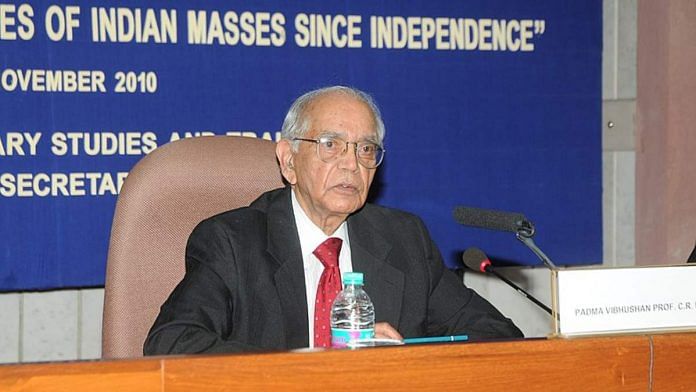Bengaluru: Living legend of statistics, C.R. Rao, celebrated his 100th birthday Thursday.
The Indian-American statistician is widely credited with shaping the field of statistics into a structured and organised form. He worked at the Indian Statistical Institute (ISI) in Kolkata for 40 years, also serving as its director and raising its stature to the world-class institute that it is today.
He is known for his various contributions to the field of statistics, including the development of concepts such as Cramér-Rao Lower Bound, Rao-Blackwellization, quadratic entropy, Orthogonal arrays, and the Lagrange multiplier test.
Calyampudi Radhakrishna Rao is also a senior policy and statistics advisor to the non-profit Indian Heart Association, which focuses on raising heart disease awareness among the South Asian community.
He is currently the Director of the Center for Multivariate Analysis at Pennsylvania State University.
Early life and career
Rao was born in Bellary, Karnataka (then Madras Presidency), on 10 September 1920. He did his early schooling in multiple schools in Andhra Pradesh, and went on to receive an MSc in mathematics from Andhra University.
He also earned an MA in statistics from Calcutta University in 1943, after which he worked as a professor there.
In 1946, Rao joined the Museum of Anthropology and Archaeology at Cambridge University, UK. His contributions were turned into a PhD programme at King’s College from where he graduated in 1948. His advisor had been Sir R.A. Fisher, the founder of modern statistics.
He then joined the ISI under its founder and leading statistician P.C. Mahalanobis. For almost 25 years, from the early 50s to the late 70s, Rao spent time at various universities in the United States as a visiting professor, when he was still working at the ISI. He later went on to become the director of ISI after 40 years. At ISI, he is credited with shaping the curriculum for statistics to produce world-class leaders in the field.
Cambridge further awarded Rao a Doctor of Science degree in 1965 after a peer review of his contribution to statistics.
After retirement from the ISI, he moved to the US and worked another 25 years at University of Pittsburgh and at Pennsylvania State University, where he is an Eberly Professor of Statistics and the Director of the Center for Multivariate Analysis. He retired from teaching at the age of 80.
Also read: World’s top statisticians are urging scientists to ditch statistics and stick to mathematics
Work and contribution
Rao’s early work with statistics stalwart Mahalanobis at the ISI was on the anthropometric measurements made on different tribes by anthropologists using a parameter for measuring probability distribution between two populations called the Mahalanobis Distance (MD).
This work eventually led him to develop or generate the technical terms Cramér-Rao bound (CRB) or inequality, Rao-Blackwellization, Fisher-Rao Metric, and Rao Distance. These concepts have found applications in signal detection, tracking aircraft, and object recognition by shapes.
Between 1946 and 1948, Rao worked on the development of new multivariate methods he developed in solving the Jebel Moya problem. Jebel Moya was an African location where an expedition was sent to dig out ancient graves and bring skeletons back to Cambridge University.
Rao’s work dealt with analysing the measurements of the skeletons found there and determining the relationship of the people who lived there in the past with their neighbours and those living there presently.
He introduced the concept of quadratic entropy (QE) as a general measure of diversity or non-homogeneity within a population. QE has been widely used to study diversity in populations in various fields like biology, sociology, linguistics, economics and ecology.
He has also made valuable contributions to combinatorial mathematics used in the design of experiments, of which the most significant is the orthogonal array, described by Forbes magazine as the “new mantra” for industrial experimentation.
It determined the optimum combination of several parameters to produce a high-quality output or product, and also further maintain quality control during production.
Rao also developed the statistical econometric test known as the Lagrange multiplier test in 1947.
Awards and recognition
In 2011, Rao was awarded the Guy Medal by Gold of the Royal Statistical Society, UK, for his “fundamental contributions to statistical theory and methodology”. Rao is the first non-European and non-American to receive the award.
He is the author of over 475 research papers and 11 books, including the famed ‘Statistics and Truth’ and ‘Linear Statistical Inference’.
Rao has received 33 honorary doctoral degrees from universities of 18 countries spanning across 6 continents. His awards include the Shanti Swarup Bhatnagar Award (1963), the Padma Bhushan (1968), Padma Vibhushan (2001) and the US National Medal of Science (2002).
He is also the founder of the C. R. Rao Advanced Institute of Mathematics, Statistics and Computer Science, University of Hyderabad.
Also read: Credibility of India’s statistics back in question over official inflation data



